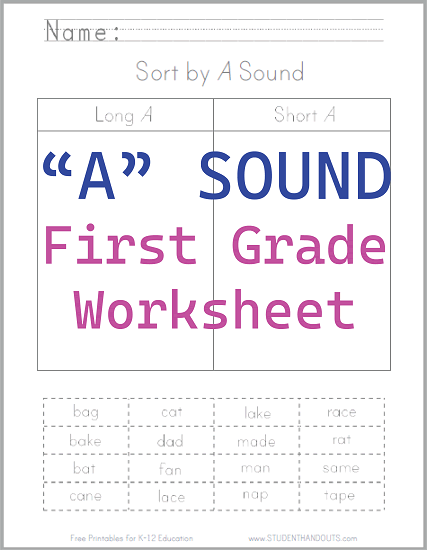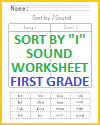| Sort by A Sound Worksheet |
|---|
| Grade One > Grade One English: Language Arts > Grade One Reading Foundational Skills |
 |  |
|---|
| Students cut apart sixteen rectangles, each containing a familiar word. Students then sort and glue each word rectangle into the appropriate box, depending upon whether it has a long a or a short a sound. Click here to print this worksheet. |
|---|
| CCSS.ELA-LITERACY.RF.1.2.A: Distinguish long from short vowel sounds in spoken single-syllable words. |
|---|
| CCSS.ELA-LITERACY.RF.2.3.A: Distinguish long and short vowels when reading regularly spelled one-syllable words. |
|---|
|
The long "A" sound is a fundamental element of the English language's phonetic system. It plays a crucial role in pronunciation, comprehension, and word recognition. Here are some reasons highlighting the importance of the long "A" sound. Phonemic Distinction: The long "A" sound is one of the vowel sounds that help distinguish words in English. For example, the words "bake" and "back" have different meanings primarily because of the presence of the long "A" sound in one and its absence in the other. Spelling and Pronunciation: Understanding the long "A" sound is essential for correctly spelling and pronouncing words. It helps learners differentiate between words that might have similar spellings but different meanings due to the pronunciation of the "A" sound. Word Families: The long "A" sound is a component of many word families, which are groups of words that share a common root or base word. Recognizing this sound helps learners identify and understand related words and their meanings. Reading and Decoding: When reading, recognizing the long "A" sound helps readers decode unfamiliar words. It aids in word recognition, which is essential for reading comprehension. Accent and Intonation: In spoken English, the pronunciation of the long "A" sound can vary based on regional accents and dialects. Understanding this variation is important for clear communication and comprehension. Language Development: For language learners, mastering the long "A" sound is part of the process of becoming fluent in English. It enables them to communicate effectively and be understood by native speakers. Rhyming and Poetry: The long "A" sound plays a role in rhyming schemes and poetic devices. Poets often use rhyme and assonance (repetition of vowel sounds) to create rhythm and meaning in their poems. Vocabulary Expansion: Learning words with the long "A" sound contributes to vocabulary development. A rich vocabulary is essential for effective communication and understanding written texts. Communication Skills: The ability to pronounce the long "A" sound accurately enhances an individual's overall communication skills, making it easier to be understood and convey meaning clearly. Literacy Development: In early childhood education, teaching and recognizing the long "A" sound is part of literacy development. It prepares young learners for reading and writing tasks as they progress in their education. The long "A" sound is a vital component of the English language's phonetic system, playing a significant role in pronunciation, spelling, reading, and communication. Its importance extends to various aspects of language learning, literacy, and effective communication in both spoken and written forms of English. |
| Grade One > Grade One English: Language Arts > Grade One Reading Foundational Skills |









